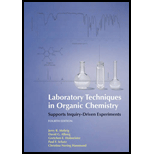
Concept explainers
Interpretation:
The more effective drying agent should be identified among
Concept introduction:
Drying agents are used to remove water from organic solvents. Mostly anhydrous drying agents are used that react with water to form insoluble hydrates in organic solvents and can be easily removed by filtration. Parameters that are considered to choose an effective drying agent are as follows:
- Capacity: The maximum number of moles of water molecules that can be trapped by a salt or drying agent defines its capacity.
- Efficiency: The amount of water left behind in the organic solvent after the drying process is called efficiency.
- Speed of removal of water: Time taken by the drying agent to form hydrate determines the speed of removal of water.
- Chemical inertness: Drying agents should be chemically inert that is it should not react with the organic solvent and the organic compounds dissolved in it.
Explanation of Solution
Among
Want to see more full solutions like this?
Chapter 11 Solutions
Laboratory Techniques in Organic Chemistry
- what is the value of the hardness index for a 750 ml sample of water contains 0.020 g of Ca^+2 and 0.005 g of Mg^+2arrow_forwardDistinguish absorption from adsorption. When you heat glassware in a drying oven, are you removing absorbed or adsorbed water?arrow_forwardWhich substance performs better in hard water, soap or detergent? Explain your answer.arrow_forward
- How much of the preservative is needed to prepare a 120-mL preparation of Aluminum hydroxide gel based on this formulation? Ammonium alum 800 g Sodium carbonate 1000g Peppermint Oil 0.01% (0.01 g/100mL) Sodium benzoate 0.1% (0.1 g/100mL) Purified water, qs ad.2000 mL a. 0.12 g b. 60 g c. 48 g d. 0.012 garrow_forwardWhy is fractional distillation more efficient than simple distillation when purifying liquid mixtures?arrow_forwardDistinguish between Chemiluminescence and Triboluminescence and give an example of each.arrow_forward
- What is water hardness? Differentiate temporary from permanent water hardness.arrow_forwardWhy do you need to add sodium carbonate in the extraction process of tea bags?arrow_forward1. An organic student did an experiment extracting benzoic acid from a mixture of other organic substances. Other analyses of the obtained sample confirmed the presence of benzoic acid. The student also measured the melting point of the white solid, 117.4-121.6 oC. The literature mp of benzoic acid is 122.3oC. What can you conclude about the sample? Select one. Group of answer choices The sample of benzoic acid contains soluble impurities. The student obtained a good yield of benzoic acid. The sample of benzoic acid contains insoluble impurities. The student obtained pure benzoic acid from the extraction. The student obtained a poor yield of benzoic acid. 2. Which phenomenon are sometimes confused with melting during mp analysis? Select all that apply. Group of answer choices decomposition cracking shaking sagging/shrinking sweating solidifying 3. Study the bond types in the compound shown. Select the type(s) of intramolecular force(s) you predict the substance to exhibit. Select all…arrow_forward
- Which of the following is true about TOTAL WATER HARDNESS? All of the choices are correct expressed as the concentration of CaCO3 present in a water sample sulfates of Ca2+ and Mg2+Ca and Mg that can be precipitated by boiling carbonates of Ca2+ and Mg2+ that does not precipitate on boilingarrow_forwardDetermine the mole fraction of p-dichlorobenzene dissolved in 1.00L of cyclohexane that shifts the vapor pressure from 78mmHg to 70 mmHg. Can you determine the mass of solute dissolved?arrow_forwardif 5 mL 10 % v/v 1,6-Diaminohexane in 3% Sodium Hydroxide and 10 mL 2% v/v Sebacoyl Chloride in Hexanes is used to make nylon6,10. If each dimer is 20 angstroms in length, calculate approximately how long (in feet or miles) a strand of nylon can be formedarrow_forward
 Chemistry: The Molecular ScienceChemistryISBN:9781285199047Author:John W. Moore, Conrad L. StanitskiPublisher:Cengage Learning
Chemistry: The Molecular ScienceChemistryISBN:9781285199047Author:John W. Moore, Conrad L. StanitskiPublisher:Cengage Learning

